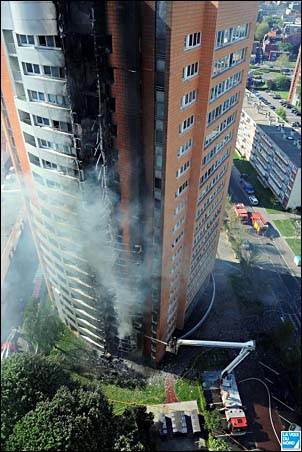
Photo : http://www.oakhillfire.org
CONTENT:
| 1. Introduction |
|
| 2. Water supply |
|
| 4. Equipment | |
| 3. Fire fighting techniques |
|
| a) 3D and Fog | |
| b) Indirect | |
| c) Direct | |
| d) Combination Attack | |
| 4. Observation | |
| 5. Controlling & Fire fighting | |
| a) Controlling Air pathways | |
| d) Positive Pressure Ventilation | |
| d) Fire Compartment Control | |
Introduction
When thinking about how air moves in a high rise building it is important to remember that during a fire, air currents may carry Oxygen to the fire and smoke away from it. High rise buildings are often designed to be sealed to the outside world. There are a range of factors and phenominon that can affect how air moves around a high rise building:
The Laws of Physics Wind Effect Built-in ventilation systems -HVAC Fire pressurisation systems Fire shafts Lift shafts (Piston affect) Stack Effect (Chimney effect) Combustion pressure Compartmentation breeching Positive Pressure Ventilation (PPV)
|
Photo: La Voix, France |
The Laws of Physics
VERY simplistically, the following should be remembered.
1. Hot air rises , Cool air falls (Convection)
2. Air with suspended contaminates (ie Smoke) is heavier than clean air.
3. Air will travel from areas of high pressure towards areas of low pressure.
4. Air carries the Oxygen a fire needs to burn.
The Wind effect
External wind can have two effects on a building.
1. It can exagerate the Stack effect by cooling the upper portions of a building (Wind is stronger at height)
2. If there are openings, it can create strong internal air tracks (air currents).
Built-in ventilation systems -HVAC
Modern High rise buildings can have complex Heating, Ventilation and Air COnditioning systems that can move large quantities or air in, out and arount the inside of a building. These are often designed with fire and smoke control in mind and have overrides shoild fire or smoke be detected.
Fire pressurisation systems
These are Fan systems that can pressurise Communial areas and escape route to keep them free of smoke during building initial evacuation. They are rarely designed to maintain a safe egress for the entire duration of fire-fighting operation.
Fire shafts
Lift shafts (Piston affect)
Stack Effect (Chimney effect)
Combustion pressure
Compartmentation breeching
Positive Pressure Ventilation (PPV)
Under developement Sept 2013
